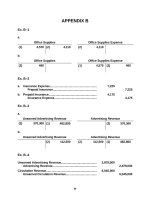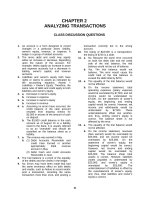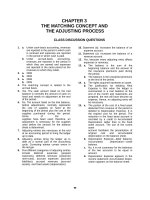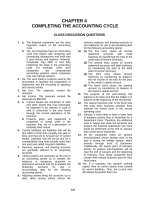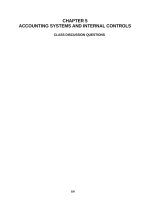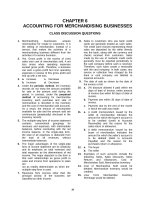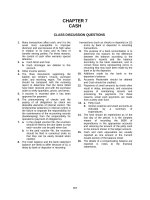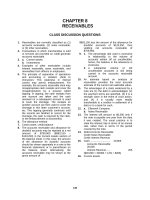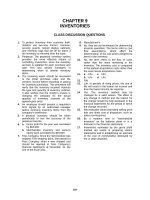Solution manual accounting 21e by warreni ch 15
Bạn đang xem bản rút gọn của tài liệu. Xem và tải ngay bản đầy đủ của tài liệu tại đây (147.27 KB, 40 trang )
CHAPTER 15
BONDS PAYABLE AND
INVESTMENTS IN BONDS
CLASS DISCUSSION QUESTIONS
1. (1) To pay the face (maturity) amount of the
bonds at a specified date. (2) To pay
periodic interest at a specified percentage
of the face amount.
2. a. Bonds that may be exchanged for other
securities under specified conditions.
b. The issuing corporation reserves the
right to redeem the bonds before the
maturity date.
c. Bonds issued on the basis of the
general credit of the corporation.
3. The phrase “time value of money” means
that an amount of cash to be received
today is worth more than the same amount
of cash to be received in the future. This is
because cash on hand today can be
invested to earn income.
4. (b) $5,000 to be received at the end of
each of the next two years has the higher
present value because cash is received
earlier than can be invested to earn
income.
5. Less
than
face
amount.
Because
comparable investments in bonds provide a
market interest rate (8%) that is greater
than the rate on the bond being purchased
(7%), the bond will sell at a discount as the
market’s means of equalizing the two
interest rates.
6. a. Greater than $7,500,000
b. 1. $7,500,000
2. 7%
3. 8%
4. $7,500,000
7. Less than the contract rate
8. a. Premium
b. $50,000
c. Premium on Bonds Payable
9. a. Debit Interest Expense
Credit Discount on Bonds Payable
b. Debit Premium on Bonds Payable
Credit Interest Expense
10. No. Because zero-coupon bonds do not
provide for interest payments, they will sell
at a discount.
11. The purpose of a bond sinking fund is to
accumulate over the life of a bond issue
enough funds to pay the indebtedness at
the maturity date.
12. The bond issue that is callable is more
risky for investors, because the company
may redeem (call) the bond issue if interest
rates fall. In addition, since the bonds may
be called at their face amount, they will sell
for a lower value than the noncallable bond
issue.
13. A loss of $8,500 [($800,000 × 0.97) –
($800,000 – $32,500)]
14. Under the caption “Investments”
15. At their cost less any amortized premium or
plus any amortized discount
169
EXERCISES
Ex. 15–1
a.
Earnings before bond interest and income tax............
Bond interest..................................................................
Balance...........................................................................
Income tax......................................................................
Net income.....................................................................
Dividends on preferred stock.......................................
Earnings available for common stock..........................
Bridger
Co.
$ 1,600,000
640,000
$ 960,000
384,000
$ 576,000
480,000
$
96,000
Earnings per share on common stock.........................
$
b. Earnings before bond interest and income tax............
Bond interest..................................................................
Balance...........................................................................
Income tax......................................................................
Net income.....................................................................
Dividends on preferred stock.......................................
Earnings available for common stock..........................
c.
0.48
$ 2,400,000
640,000
$ 1,760,000
704,000
$ 1,056,000
480,000
$ 576,000
Earnings per share on common stock.........................
$
2.88
Earnings before bond interest and income tax...........
Bond interest..................................................................
Balance...........................................................................
Income tax......................................................................
Net income.....................................................................
Dividends on preferred stock.......................................
Earnings available for common stock..........................
$ 4,000,000
640,000
$ 3,360,000
1,344,000
$ 2,016,000
480,000
$ 1,536,000
Earnings per share on common stock.........................
$
7.68
Ex. 15–2
Factors other than earnings per share that should be considered in evaluating
financing plans include: bonds represent a fixed annual interest requirement,
while dividends on stock do not; bonds require the repayment of principal, while
stock does not; and common stock represents a voting interest in the ownership
of the corporation, while bonds do not.
Ex. 15–3
Home Depot’s major source of financing is common stock. It has long-term debt,
excluding current installments, of $1,321,000,000, compared to stockholders’
equity of $19,802,000,000.
Ex. 15–4
a.
$100,000 ÷ 1.05 = $95,238
$ 95,238 ÷ 1.05 = $90,703
$ 90,703 ÷ 1.05 = $86,384
b. $100,000 × 0.86384 = $86,384
Ex. 15–5
a.
First Year:
$50,000 × 0.94340 = $ 47,170.00
Second Year: $50,000 × 0.89000 =
44,500.00
Third Year:
$50,000 × 0.83962 =
41,981.00
Fourth Year: $50,000 × 0.79209 =
39,604.50
Total present value
$173,255.50
b. $50,000 × 3.46511 = $173,255.50
Ex. 15–6
$1,000,000 × 12.78336 = $12,783,360
Ex. 15–7
No. The present value of your winnings using an interest rate of 12% is $7,843,140
($1,000,000 × 7.84314), which is more than one-half of the present value of your
winnings using an interest rate of 6% ($12,783,360; see Ex. 15–6). This is because
of the effect of compounding the interest. That is, compound interest functions
are not linear functions, but use exponents.
Ex. 15–8
Present value of $1 for 10 (semiannual)
periods at 6% (semiannual rate)..........................
Face amount of bonds...............................................
Present value of an annuity of $1
for 10 periods at 6%.............................................
Semiannual interest payment...................................
Total present value (proceeds).................................
0.55840
× $12,000,000
×
7.36009
$480,000
$ 6,700,800
3,532,843
$ 10,233,643
Ex. 15–9
Present value of $1 for 10 (semiannual)
periods at 5% (semiannual rate)..........................
Face amount of bonds...............................................
Present value of an annuity of $1
for 10 periods at 5%.............................................
Semiannual interest payment...................................
Total present value (proceeds).................................
0.61391
× $40,000,000
7.72174
× $2,200,000
$24,556,400
16,987,828
$41,544,228
Ex. 15–10
The bonds were selling at a premium. This is indicated by the selling price of
103.536, which is stated as a percentage of face amount and is more than par
(100%). The market rate of interest for similar quality bonds was lower than
2.125%, and this is why the bonds were selling at a premium.
Ex. 15–11
May
Nov.
1
1
Dec. 31
Cash.....................................................................
Bonds Payable................................................
18,000,000
Interest Expense.................................................
Cash.................................................................
630,000
Interest Expense.................................................
Interest Payable...............................................
210,000
18,000,000
630,000
210,000
Ex. 15–12
a.
1. Cash..........................................................................
Discount on Bonds Payable....................................
Bonds Payable....................................................
7,095,482
904,518
2. Interest Expense.......................................................
Cash.....................................................................
320,000
3. Interest Expense.......................................................
Cash.....................................................................
320,000
4. Interest Expense.......................................................
Discount on Bonds Payable...............................
$904,518 ÷ 5 years = $180,904
180,904
8,000,000
320,000
320,000
180,904
b. Annual interest paid......................................................
Plus discount amortized...............................................
Interest expense for first year.......................................
$ 640,000
180,904
$ 820,904
Note: The following data in support of the proceeds of the bond issue stated
in the exercise are presented for the instructor’s information. Students are
not required to make the computations.
Present value of $1 for 10 (semiannual)
periods at 5 1/2% (semiannual rate)...................
Face amount........................................................
Present value of annuity of $1 for 10
periods at 5 1/2%.................................................
Semiannual interest payment.............................
Total present value of bonds payable................
0.58543
× $ 8,000,000 $ 4,683,440
×
7.53763
$320,000
2,412,042
$ 7,095,482
Ex. 15–13
a.
Cash..........................................................................
Premium on Bonds Payable...............................
Bonds Payable....................................................
7,789,543
289,543
7,500,000
Note: The following data are in support of the determination of the proceeds
of the bond issue stated in the exercise:
Present value of $1 for 10 (semiannual)
periods at 5% (semiannual rate).........................
0.61391
Face amount............................................................. × $7,500,000
$ 4,604,325
Present value of an annuity of $1 for 10
periods at 5%.......................................................
Semiannual interest payment.................................. ×
Proceeds...................................................................
3,185,218
$ 7,789,543
b. Interest Expense.......................................................
Premium on Bonds Payable.....................................
Cash.....................................................................
7.72174
$412,500
383,546
28,954*
412,500
*$289,543 ÷ 10 semiannual payments
Ex. 15–14
2006
Apr. 1
Oct.
1
2010
Oct. 1
Cash.....................................................................
Bonds Payable................................................
12,000,000
Interest Expense.................................................
Cash.................................................................
480,000
Bonds Payable.....................................................
Loss on Redemption of Bonds..........................
Cash.................................................................
12,000,000
240,000
12,000,000
480,000
12,240,000
Ex. 15–15
2006
Jan. 1
July
1
2012
July 1
Cash.....................................................................
Bonds Payable................................................
18,000,000
Interest Expense.................................................
Cash.................................................................
810,000
Bonds Payable.....................................................
Gain on Redemption of Bonds.......................
Cash.................................................................
18,000,000
18,000,000
810,000
540,000
17,460,000
Ex. 15–16
1.
The significant loss on redemption of the series X bonds should be reported
in the Other Income and Expense section of the income statement, rather than
as an extraordinary loss.
2. The series Y bonds outstanding at the end of the current year should be
reported as a noncurrent liability on the balance sheet because they are to be
paid from funds set aside in a sinking fund.
Ex. 15–17
The discount of $811 ($1,000 – $189) is amortized as interest revenue over the life
of the bonds, using the straight-line method (illustrated in this chapter) or the
interest method (illustrated in the appendix to this chapter).
Ex. 15–18
a.
Investment in Pierce Co. Bonds...................................
Interest Revenue............................................................
Cash..........................................................................
456,750
9,000
b. Cash................................................................................
Interest Revenue......................................................
18,000
c.
465,750
18,000
Interest Revenue............................................................
Investment in Pierce Co. Bonds..............................
540
d. Cash................................................................................
Loss on Sale of Investments.........................................
Investment in Pierce Co. Bonds..............................
Interest Revenue......................................................
448,500
8,250
540
453,750
3,000
Ex. 15–19
a.
Investment in Theisen Co. Bonds.................................
Interest Revenue............................................................
Cash..........................................................................
264,600
2,250
b. Cash................................................................................
Interest Revenue......................................................
6,750
c.
266,850
6,750
Investment in Theisen Co. Bonds.................................
Interest Revenue......................................................
450
d. Cash................................................................................
Investment in Theisen Co. Bonds...........................
Gain on Sale of Investments....................................
Interest Revenue......................................................
274,500
450
267,250
2,750
4,500
Ex. 15–20
a.
Current year:
Number of times interest charges earned: 4.7 =
Preceding year:
Number of times interest charges earned: 12.6 =
$392,682,0 00 + $106,023,0 00
$106,023,0 00
$827,659,0 00 + $69,827,00 0
$69,827,00 0
b. The number of times interest charges earned has declined from 12.6 to 4.7 in
the current year. Although Southwest Airlines has adequate earnings to pay
interest, the decline in this ratio would potentially cause concern among debtholders.
Appendix Ex. 15–21
a.
1. Cash..........................................................................
Discount on Bonds Payable....................................
Bonds Payable....................................................
7,095,482
904,518
2. Interest Expense.......................................................
Cash.....................................................................
320,000
3. Interest Expense.......................................................
Cash.....................................................................
320,000
4. Interest Expense.......................................................
Discount on Bonds Payable...............................
144,367
8,000,000
320,000
320,000
144,367
Computations:
$7,095,482 × 0.055 = $390,252
$390,252 – $320,000 = $70,252 first semiannual amortization
$7,095,482 + $70,252 = $7,165,734
$7,165,734 × 0.055 = $394,115
$394,115 – $320,000 = $74,115 second semiannual amortization
$70,252 + $74,115 = $144,367 amortization for first year
Note: The following data in support of the proceeds of the bond issue stated
in the exercise are presented for the instructor’s information. Students are
not required to make the computations.
Present value of $1 for 10 (semiannual)
periods at 5 1/2% (semiannual rate)........................
Face amount.............................................................
Present value of annuity of $1 for
10 periods at 5 1/2%.................................................
Semiannual interest payment..................................
Total present value of bonds payable.....................
b. Annual interest paid......................................................
Plus discount amortized...............................................
Interest expense for first year.......................................
0.58543
× $8,000,000 $ 4,683,440
×
7.53763
$320,000
2,412,042
$ 7,095,482
$640,000
144,367
$784,367
Appendix Ex. 15–22
a.
1. Interest Expense.......................................................
Cash.....................................................................
412,500
2. Interest Expense.......................................................
Cash.....................................................................
412,500
3. Premium on Bonds Payable....................................
Interest Expense.................................................
47,197
412,500
412,500
47,197
Computations:
$7,789,543 × 5% = $389,477
$412,500 – $389,477 = $23,023 first semiannual amortization
$7,789,543 – $23,023 = $7,766,520
$7,766,520 × 5% = $388,326
$412,500 – $388,326 = $24,174 second semiannual amortization
$23,023 + $24,174 = $47,197 first year amortization
b. Annual interest paid......................................................
Less premium amortized...............................................
Interest expense for first year.......................................
$825,000
47,197
$777,803
Appendix Ex. 15–23
a.
Present value of $1 for 10 (semiannual)
periods at 5 1/2% (semiannual rate)...................
0.58543
Face amount............................................................. × $32,500,000
$19,026,475
Present value of annuity of $1 for 10
periods at 5 1/2%.................................................
7.53763
Semiannual interest payment.................................. × $1,950,000
Proceeds of bond sale.............................................
14,698,378
$33,724,853
b. First semiannual interest payment..........................
5 1/2% of carrying amount of $33,724,853..............
Premium amortized..................................................
$ 1,950,000
1,854,867
$
95,133
c.
$ 1,950,000
1,849,635
$ 100,365
Second semiannual interest payment.....................
5 1/2% of carrying amount of $33,629,720*.............
Premium amortized..................................................
*$33,724,853 – $95,133 = $33,629,720
d. Annual interest paid.................................................
Less premium amortized.........................................
Interest expense for first year.................................
*$95,133 + $100,365 = $195,498
$ 3,900,000
195,498*
$ 3,704,502
Appendix Ex. 15–24
a.
Present value of $1 for 10 (semiannual)
periods at 6% (semiannual rate).........................
0.55840
Face amount............................................................. × $17,500,000
$ 9,772,000
Present value of annuity of $1 for 10 periods at 6%...
Semiannual interest payment.................................. ×
Proceeds of bond sale.............................................
6,440,079
$16,212,079
7.36009
$875,000
b. 6% of carrying amount of $16,212,079....................
First semiannual interest payment..........................
Discount amortized..................................................
$
c.
$
6% of carrying amount of $16,309,804*...................
Second semiannual interest payment.....................
Discount amortized..................................................
$
$
972,725
875,000
97,725
978,588
875,000
103,588
*$16,212,079 + $97,725 = $16,309,804
d. Annual interest paid.................................................
Plus discount amortized..........................................
Interest expense first year.......................................
*$97,725 + $103,588 = $201,313
$ 1,750,000
201,313*
$ 1,951,313
PROBLEMS
Prob. 15–1A
1.
Earnings before interest and income tax......
Deduct interest on bonds...............................
Income before income tax..............................
Deduct income tax..........................................
Net income.......................................................
Dividends on preferred stock.........................
Available for dividends on common stock....
Shares of common stock outstanding..........
Earnings per share on common stock...........
Plan 1
$15,000,000
—
$15,000,000
6,000,000
$ 9,000,000
—
$ 9,000,000
÷ 4,000,000
$
2.25
Plan 2
$15,000,000
—
$15,000,000
6,000,000
$ 9,000,000
600,000
$ 8,400,000
÷ 2,000,000
$
4.20
Plan 3
$15,000,000
1,000,000
$14,000,000
5,600,000
$ 8,400,000
300,000
$ 8,100,000
÷ 1,000,000
$
8.10
2.
Earnings before interest and income tax......
Deduct interest on bonds...............................
Income before income tax..............................
Deduct income tax..........................................
Net income.......................................................
Dividends on preferred stock.........................
Available for dividends on common stock....
Shares of common stock outstanding..........
Earnings per share on common stock...........
Plan 1
$ 1,600,000
—
$ 1,600,000
640,000
$ 960,000
—
$ 960,000
÷ 4,000,000
$
0.24
Plan 2
$ 1,600,000
—
$ 1,600,000
640,000
$ 960,000
600,000
$ 360,000
÷ 2,000,000
$
0.18
Plan 3
$ 1,600,000
1,000,000
$ 600,000
240,000
$ 360,000
300,000
$
60,000
÷ 1,000,000
$
0.06
Prob. 15–1A
3.
Concluded
The principal advantage of Plan 1 is that it involves only the issuance of
common stock, which does not require a periodic interest payment or return
of principal, and a payment of preferred dividends is not required. It is also
more attractive to common shareholders than is Plan 2 or 3 if earnings before
interest and income tax is $1,600,000. In this case, it has the largest EPS
($0.24). The principal disadvantage of Plan 1 is that it requires an additional
investment by present common shareholders to retain their current interest in
the company. Also, if earnings before interest and income tax is $15,000,000,
this plan offers the lowest EPS ($2.25) on common stock.
The principal advantage of Plan 3 is that little additional investment would
need to be made by common shareholders for them to retain their current
interest in the company. Also, it offers the largest EPS ($8.10) if earnings
before interest and income tax is $15,000,000. Its principal disadvantage is
that the bonds carry a fixed annual interest charge and require the payment of
principal. It also requires a dividend payment to preferred stockholders
before a common dividend can be paid. Finally, Plan 3 provides the lowest
EPS ($0.06) if earnings before interest and income tax is $1,600,000.
Plan 2 provides a middle ground in terms of the advantages and
disadvantages described in the preceding paragraphs for Plans 1 and 3.
Prob. 15–2A
1.
Cash..........................................................................
Premium on Bonds Payable...............................
Bonds Payable....................................................
10,121,603*
1,121,603
9,000,000
*Present value of $1 for 20 (semiannual)
periods at 5% (semiannual rate).........................
0.37689
Face amount............................................................. × $9,000,000
Present value of an annuity of $1 for 20
periods at 5%.......................................................
12.46221
Semiannual interest payment.................................. × $540,000
Proceeds of bond issue...........................................
2.
3.
a. Interest Expense.................................................
Premium on Bonds Payable ($1,121,603 ÷ 20). .
Cash................................................................
483,920
56,080
b. Interest Expense.................................................
Premium on Bonds Payable...............................
Cash................................................................
483,920
56,080
$ 3,392,010
6,729,593
$ 10,121,603
540,000
540,000
$483,920
4. Yes. Investors will be willing to pay more than the face amount of the bonds
when the interest payments they will receive from the bonds exceed the
amount of interest that they could receive from investing in other bonds.
Prob. 15–2A
Concluded
This solution is applicable only if the P.A.S.S. Software that accompanies the text
is used.
REST-IN-PEACE CORPORATION
Balance Sheet
June 30, 2007
Assets
Cash.................................................................................... $10,434,403
Accounts receivable..........................................................
602,200
Merchandise inventory......................................................
809,300
Prepaid insurance..............................................................
46,400
Supplies.............................................................................
85,000
Total current assets...........................................................
$11,977,303
Equipment.......................................................................... $ 1,132,900
Accumulated depreciation—equipment...........................
(69,000)
Total plant assets...............................................................
1,063,900
Total assets........................................................................
$13,041,203
Liabilities
Accounts payable..............................................................
$ 835,100
Bonds payable................................................................... $ 9,000,000
Premium on bonds payable..............................................
1,009,443
Total long-term liabilities...................................................
10,009,443
Total liabilities....................................................................
$10,844,543
Stockholders’ Equity
Paid-in capital:
Preferred stock........................................................... $ 600,000
Excess of issue price over par—preferred stock.....
75,000
Common stock............................................................
400,000
Excess of issue price over par—common stock......
200,000
From sale of treasury stock.......................................
11,000
Total paid-in capital........................................................... $ 1,286,000
Retained earnings..............................................................
931,660
Total.................................................................................... $ 2,217,660
Less treasury stock...........................................................
21,000
Total stockholders’ equity.................................................
2,196,660
Total liabilities and equity.................................................
$13,041,203
Prob. 15–3A
1.
Cash..........................................................................
Discount on Bonds Payable....................................
Bonds Payable....................................................
10,623,552*
1,376,448
12,000,000
*Present value of $1 for 20 (semiannual)
periods at 6% (semiannual rate).........................
0.31180
Face amount............................................................. × $12,000,000
Present value of an annuity of $1 for 20
periods at 6%.......................................................
11.46992
Semiannual interest payment.................................. ×
$600,000
2.
a. Interest Expense.................................................
Discount on Bonds Payable
($1,376,448 ÷ 20)............................................
Cash................................................................
668,822
b. Interest Expense.................................................
Discount on Bonds Payable..........................
Cash................................................................
668,822
$ 3,741,600
6,881,952
$10,623,552
68,822
600,000
68,822
600,000
3.
$668,822
4.
Yes. Investors will not be willing to pay the face amount of the bonds when
the interest payments they will receive from the bonds are less than the
amount of interest that they could receive from investing in other bonds.
Prob. 15–4A
1.
2005
July
Dec.
2006
June
Dec.
2007
June
1 Cash..............................................................
Discount on Bonds Payable........................
Bonds Payable.........................................
7,382,236
617,764
31 Interest Expense...........................................
Cash.........................................................
320,000
31 Interest Expense...........................................
Discount on Bonds Payable...................
61,776
31 Income Summary..........................................
Interest Expense.....................................
381,776
30 Interest Expense...........................................
Cash.........................................................
320,000
31 Interest Expense...........................................
Cash.........................................................
320,000
31 Interest Expense...........................................
Discount on Bonds Payable...................
123,552
31 Income Summary..........................................
Interest Expense.....................................
763,552
30 Bonds Payable..............................................
Loss on Redemption of Bonds....................
Discount on Bonds Payable...................
Cash.........................................................
8,000,000
290,660
2.
a.
b.
3.
Initial carrying amount of bonds...................................
Discount amortized on December 31, 2005.................
Discount amortized on December 31, 2006.................
Carrying amount of bonds, December 31, 2006...........
8,000,000
320,000
61,776
381,776
320,000
320,000
123,552
763,552
370,660
7,920,000
2005: $381,776
2006: $763,552
$7,382,236
61,776
123,552
$7,567,564
Prob. 15–4A
Concluded
This solution is applicable only if the P.A.S.S. Software that accompanies the text
is used.
PRAIRIE RENAISSANCE INC.
Balance Sheet
June 30, 2007
Assets
Cash.................................................................................... $10,206,812
Accounts receivable..........................................................
1,352,200
Merchandise inventory......................................................
809,300
Prepaid insurance..............................................................
46,400
Supplies.............................................................................
85,000
Total current assets...........................................................
$12,499,712
Equipment.......................................................................... $ 1,882,900
Accumulated depreciation—equipment...........................
(69,000)
Total plant assets...............................................................
1,813,900
Total assets........................................................................
$ 14,313,612
Liabilities
Accounts payable..............................................................
$
835,100
Stockholders’ Equity
Paid-in capital:
Preferred stock........................................................... $ 4,600,000
Excess of issue price over par—preferred stock.....
1,075,000
Common stock............................................................
4,400,000
Excess of issue price over par—common stock......
1,200,000
From sale of treasury stock.......................................
11,000
Total paid-in capital........................................................... $ 11,286,000
Retained earnings..............................................................
2,213,512
Total.................................................................................... $13,499,512
Less treasury stock...........................................................
21,000
Total stockholders’ equity.................................................
13,478,512
Total liabilities and equity.................................................
$14,313,612
Prob. 15–5A
2005
Sept. 1
Dec. 31
31
2011
June 30
Aug. 31
31
Investment in Sheehan Company Bonds...........
Interest Revenue ($480,000 × 8% × 2/12)...........
Cash.................................................................
494,750
6,400
Cash.....................................................................
Interest Revenue.............................................
19,200
Interest Revenue.................................................
Investment in Sheehan Company Bonds......
500
Cash.....................................................................
Interest Revenue.............................................
19,200
Interest Revenue.................................................
Investment in Sheehan Company Bonds......
500
Cash.....................................................................
Gain on Sale of Investments..........................
Investment in Sheehan Company Bonds......
Interest Revenue.............................................
501,150
19,200
500
19,200
500
247,600*
1,525
242,875
3,200
*($240,000 × 1.02) + ($240,000 × 8% × 2/12) – $400
Dec. 31
31
Cash.....................................................................
Interest Revenue.............................................
9,600
Interest Revenue.................................................
Investment in Sheehan Company Bonds......
750
9,600
750
Appendix Prob. 15–6A
1.
a. Interest Expense.......................................................
Premium on Bonds Payable
[$540,000 – (5% × $10,121,603)]...............................
Cash.....................................................................
506,080
b. Interest Expense.......................................................
Premium on Bonds Payable
[$540,000 – (5% × $10,087,683)]...............................
Cash.....................................................................
504,384
33,920
540,000
35,616
540,000
2. $506,080
Appendix Prob. 15–7A
1.
a. Interest Expense.......................................................
Discount on Bonds Payable
[($10,623,552 × 6%) – $600,000].........................
Cash.....................................................................
637,413
b. Interest Expense.......................................................
Discount on Bonds Payable
[($10,660,965 × 6%) – $600,000].........................
Cash.....................................................................
639,658
2. $637,420
37,413
600,000
39,658
600,000
Prob. 15–1B
1.
Earnings before interest and income tax......
Deduct interest on bonds...............................
Income before income tax..............................
Deduct income tax..........................................
Net income.......................................................
Dividends on preferred stock.........................
Available for dividends on common stock....
Shares of common stock outstanding..........
Earnings per share on common stock...........
Plan 1
$ 4,500,000
—
$ 4,500,000
1,800,000
$ 2,700,000
—
$ 2,700,000
÷ 1,800,000
$
1.50
Plan 2
$ 4,500,000
—
$ 4,500,000
1,800,000
$ 2,700,000
1,080,000
$ 1,620,000
÷ 900,000
$
1.80
Plan 3
$ 4,500,000
1,350,000
$ 3,150,000
1,260,000
$ 1,890,000
720,000
$ 1,170,000
÷ 450,000
$
2.60
2.
Earnings before interest and income tax......
Deduct interest on bonds...............................
Income before income tax..............................
Deduct income tax..........................................
Net income.......................................................
Dividends on preferred stock.........................
Available for dividends on common stock....
Shares of common stock outstanding..........
Earnings per share on common stock...........
Plan 1
$ 2,700,000
—
$ 2,700,000
1,080,000
$ 1,620,000
—
$ 1,620,000
÷ 1,800,000
$
0.90
Plan 2
$ 2,700,000
—
$ 2,700,000
1,080,000
$ 1,620,000
1,080,000
$ 540,000
÷ 900,000
$
0.60
Plan 3
$ 2,700,000
1,350,000
$ 1,350,000
540,000
$ 810,000
720,000
$
90,000
÷ 450,000
$
0.20
Prob. 15–1B
3.
Concluded
The principal advantage of Plan 1 is that it involves only the issuance of
common stock, which does not require a periodic interest payment or return
of principal, and a payment of preferred dividends is not required. It is also
more attractive to common shareholders than is Plan 2 or 3 if earnings before
interest and income tax is $2,700,000. In this case, it has the largest EPS
($0.90). The principal disadvantage of Plan 1 is that it requires an additional
investment by present common shareholders to retain their current interest in
the company. Also, if earnings before interest and income tax is $4,500,000,
this plan offers the lowest EPS ($1.50) on common stock.
The principal advantage of Plan 3 is that little additional investment would
need to be made by common shareholders for them to retain their current
interest in the company. Also, it offers the largest EPS ($2.60) if earnings
before interest and income tax is $4,500,000. Its principal disadvantage is that
the bonds carry a fixed annual interest charge and require the payment of
principal. It also requires a dividend payment to preferred stockholders
before a common dividend can be paid. Finally, Plan 3 provides the lowest
EPS ($0.20) if earnings before interest and income tax is $2,700,000.
Plan 2 provides a middle ground in terms of the advantages and
disadvantages described in the preceding paragraphs for Plans 1 and 3.
Prob. 15–2B
1.
Cash........................................................................
Premium on Bonds Payable.............................
Bonds Payable..................................................
*Present value of $1 for 20 (semiannual)
periods at 5% (semiannual rate)......................
Face amount...........................................................
Present value of an annuity of $1 for 20
periods at 5%....................................................
Semiannual interest payment................................
Proceeds of bond issue........................................
2.
21,246,231*
1,246,231
20,000,000
0.37689
× $20,000,000
12.46221
× $1,100,000
a. Interest Expense.................................................
Premium on Bonds Payable ($1,246,231 ÷ 20). .
Cash................................................................
1,037,688
62,312
b. Interest Expense.................................................
Premium on Bonds Payable...............................
Cash................................................................
1,037,688
62,312
$ 7,537,800
13,708,431
$ 21,246,231
1,100,000
1,100,000
3.
$1,037,688
4.
Yes. Investors will be willing to pay more than the face amount of the bonds
when the interest payments they will receive from the bonds exceed the
amount of interest that they could receive from investing in other bonds.
Prob. 15–2B
Concluded
This solution is applicable only if the P.A.S.S. Software that accompanies the text
is used.
FRONTIER INC.
Balance Sheet
June 30, 2006
Assets
Cash..............................................................
$23,784,131
Accounts receivable.....................................
228,950
Merchandise inventory.................................
2,681,650
Prepaid insurance.........................................
139,650
Supplies........................................................
182,950
Total current assets......................................
$ 27,017,331
Equipment..................................................... $ 1,390,000
Accumulated depreciation—equipment.....
(109,600) $ 1,280,400
Building......................................................... $ 5,405,000
Accumulated depreciation—building.........
(672,000)
4,733,000
Total plant assets.........................................
6,013,400
Total assets...................................................
$ 33,030,731
Liabilities
Accounts payable..............................................................
$
32,000
Bonds payable................................................................... $20,000,000
Premium on bonds payable..............................................
1,121,607
Total long-term liabilities...................................................
21,121,607
Total liabilities....................................................................
$ 21,153,607
Stockholders’ Equity
Paid-in capital:
Preferred stock........................................................... $ 2,100,000
Excess of issue price over par—preferred stock.....
172,500
Common stock............................................................
4,500,000
Excess of issue price over par—common stock......
1,100,000
From sale of treasury stock.......................................
2,000
Total paid-in capital........................................................... $ 7,874,500
Retained earnings..............................................................
4,222,624
Total.................................................................................... $ 12,097,124
Less treasury stock...........................................................
220,000
Total stockholders’ equity.................................................
11,877,124
Total liabilities and equity.................................................
$ 33,030,731
Prob. 15–3B
1.
Cash..........................................................................
Discount on Bonds Payable....................................
Bonds Payable....................................................
16,878,410*
1,121,590
18,000,000
*Present value of $1 for 20 (semiannual)
periods at 5% (semiannual rate).........................
0.37689
Face amount............................................................. × $18,000,000
Present value of an annuity of $1 for 20
periods at 5%.......................................................
12.46221
Semiannual interest payment.................................. ×
$810,000
Proceeds of bond issue...........................................
2.
a. Interest Expense.................................................
Discount on Bonds Payable
($1,121,590 ÷ 20).............................................
Cash................................................................
866,080
b. Interest Expense.................................................
Discount on Bonds Payable..........................
Cash................................................................
866,080
$ 6,784,020
10,094,390
$ 16,878,410
56,080
810,000
56,080
810,000
3.
$866,080
4.
Yes. Investors will not be willing to pay the face amount of the bonds when
the interest payments they will receive from the bonds are less than the
amount of interest that they could receive from investing in other bonds.
